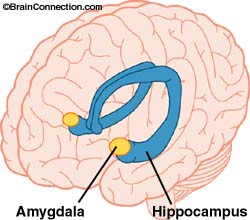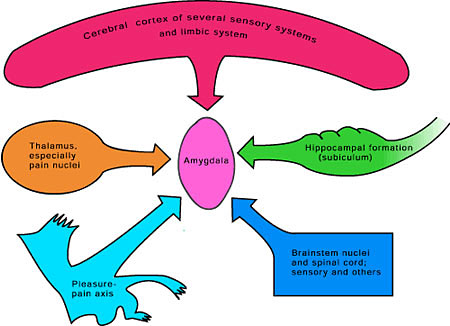Amygdala
From Psy3242
Contents |
Overview
The amygdala represents an anatomical structure of the brain that is involved in a range of behavioral and mental conditions (LeDoux, 2007). Previously, this area had received little scientific recognition, but now it is one of the most extensively studied brain regions. The name “amygdala” is rooted in Greek and refers to the almond-shaped structure located bilaterally within the temporal lobes of the limbic system (LeDoux, 2007). Most individuals assume the amygdala to be comprised of a single mass; however, its composition includes several nuclei, which can be found in species of higher cognitive functioning, including humans and primates. Consistent with this view, it can be argued that the amygdala is not a unitary structure or function, but rather accords several regions that contribute to cognitive functions of other areas in the brain (LeDoux, 2007). In specific, the lateral and basal amygdala are viewed as nuclear extensions of the cortex, while the central and medial nuclei are part of ventral expansions of the striatum and each of these areas can further be divided into subnuclei, which are all relevant to the study of this anatomical region. For example, the dorsal subcomponent of the lateral nucleus is said to be involved in varying aspects of fear memory (LeDoux, 2007).
Connectivity
The importance of connectivity points to the ability for specific areas of the brain to make connections with other related regions for the purpose of function (LeDoux, 2007). For instance, the lateral amygdala is responsible for receiving stimulatory input from different sensory systems, such as the visual, somatosensory, olfactory, and auditory modalities (LeDoux, 2007). These inputs are then transferred and consummated in the dorsal subnucleus. This subregion then relays information to the ventrolateral and medial areas in order to connect with other areas of the amygdala (LeDoux, 2007). The region most notable in behavioral and physiological output is the central nucleus, in which connections from the medial subarea and other interconnected nuclei (e.g. basal nucleus) are involved, at least for the expression of emotional responses. As previously mentioned, areas in the striatum also connect with the central nucleus in instrumental behaviors (LeDoux, 2007). More specifically, sensory output from the central amygdala to the brainstem results in the management of emotions, but the interconnectivity between the basal subregion and the striatum are responsible for controlling action-based behaviors, like running from a potential marauder. Finally, the extent to which the connections are successful in relaying communication relies on the role of various neurotransmitter systems, such as dopamine and serotonin, thereby resulting in exhibitory and inhibitory behavioral responses (LeDoux, 2007).
Behavior
In the early 20th century, observed damage in the temporal lobe showed profound changes in behaviors such as fear and sex-related responses (LeDoux, 2007). After determining that the amygdala played a role in these impairments, the inability to account for the underlying substructures of this area resulted in a body of research that was widely misunderstood. It was not until after the discovery of the amygdala’s subcomponents, in which researchers were able to study specific behavioral functions associated with this region (LeDoux, 2007).
Fear
Fear has been documented throughout scientific literature and more specifically, use of Pavlovian conditioning (the seemingly innate ability to learn stimulus-response (SR) affiliations when presented with associative stimuli) has been shown to consistently and effectively measure such behavior (LeDoux, 2007). The habituation of these associations, through prolonged exposure, implies the developmental aspect of plasticity to aid in the maintenance of short-term memory. Moreover, when these SR associations are re-presented to an individual, the enduring plasticity reveals storage of the appropriate information to the individual’s long-term memory (LeDoux, 2007).
Other
While fear response continues to be the most salient behavioral function associated with the amygdala, other research has pointed out that this region is also involved in other emotions such as aggression, sexuality, and addictive, ingestive behaviors (e.g. eating and drinking). Additionally, the amygdala’s ability to release hormones, through neurotransmitter modalities, to other regions of the brain also influences other specific types of cognition, such as attention, perception, and explicit memory (LeDoux, 2007). In other words, the amygdala’s emotional processing to external stimuli establishes connections with other functions of the brain. As earlier noted, the amygdala plays a role in several psychiatric conditions, like autism, schizophrenia, borderline personality disorder, and depression. More importantly, the amygdala is not the cause of these disorders, but rather alterations in the representation of this region result in specific behavioral changes in these individuals (LeDoux, 2007).
Relevant Studies
Bechara, Tranel, Damasio, Adolphs, Rockland, and Damasio (1995) studied the double dissociation between conditioning and declarative knowledge in relation to the amygdala and the hippocampus in three patients. In two conditioning experiments, using a skin conductance response (SCR) measure, the researchers found that the patient with bilateral damage to the amygdala was unable to acquire the conditioned autonomic responses to the presented visual or auditory stimuli; however, declarative knowledge of the stimuli was largely spared (Bechara et al., 1995). Conversely, the patient with hippocampal damage was able to acquire the conditioned autonomic responses, but failed to retain declarative knowledge of the material. Lastly, the third patient had damage to both brain areas, resulting in an inability to acquire both conditioned autonomic responses and declarative facts. Consistent with previous research, this study further suggested the role the amygdala plays in associative cues of affect, while the hippocampus is responsible for learning the critical relationships among these cues (Bechara et al., 1995).
A later study conducted by Bechara, Damasio, Damasio, and Lee (1999) focused on the contributions of the amygdala and the ventromedial prefrontal (VMF) cortex in human decision-making. Using the “gambling task” to measure decision-making and a skin conductance response (SCR) instrument, the researchers were able to effectively study a group of patients with bilateral amygdala damage and another group with VMF bilateral damage (Bechara et al., 1999). In a Pavlovian conditioning experiment, participants were also tested for acquisition of a conditioned SCR to paired visual stimuli and an aversive loud noise (Bechara et al., 1999). Results of the study revealed that the two areas have distinct influences on decision-making. More specifically, patients with amygdala damage were unable to produce SCRs on both the “gambling task” as well as the conditioning experiment. The group of individuals with VMF damage were also unable to generate SCRs on the “gambling task,” but were able to produce a response when presented with a reward or punishment (e.g. play money), while the amygdala-damaged patients still failed to produce such a response when they received similar reinforcements (Bechara et al., 1999).
The differences associated with decision-making in the two groups implies potentially bigger consequences for the patients with bilateral amygdala damage, in that the failure to evoke the appropriate somatic state results in impairment of future decision-making tasks that elicit similar somatic affects (Bechara, 1999). In sum, this study paralleled earlier research about the underlying functions of the orbitofrontal cortex and the basolateral amygdala and their association with goal-directed behavior. While both groups of patients showed impairments on similar decision-making tasks, the individuals with bilateral damage to the amygdala are much more susceptible to both psychologically and physically harmful real-life situations, where a decision may be critical (Bechara, 1999). In other words, their overall failure to adequately respond to external stimuli due to alterations in emotional states (e.g. fear), may therefore cause such individuals to choose a course of action, in which an unfavorable outcome could result in devastating mental and/or physical consequences.
Interesting fact
The amygdala is responsible for the emotional reactions to music.
References
Bechara, A., Tranel, D., Damasio, H., Adolphs, R., Rockland, C., & Damasio, A. R. (1995). Double dissociation of conditioning and declarative knowledge relative to the amygdala and hippocampus in humans. Science, 269, 1115-1118.
Bechara, A., Damasio, H., Damasio, A. R., & Lee, G. P. (1999). Different contributions of the human amygdala and ventromedial prefrontal cortex to decision-making. The Journal of Neuroscience, 19(3), 5473-5481.
LeDoux, J. (2007). The amygdala. Current Biology, 17, 868-874.



